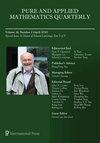准周期强迫 NLS 的可重复性和非线性稳定性
IF 0.8
4区 数学
Q3 MATHEMATICS
引用次数: 0
摘要
受二维环$\mathbb{T}^2 := (\mathbb{R}/2 \pi \mathbb{Z})^2$上的非线性三次薛定谔方程(NLS)的 KAM 环的长期稳定性与不稳定性问题的启发,我们考虑了在 KAM 环上由 NLS 的线性化引起的 $\mathbb{T}^2$ 上的准周期强迫 NLS 方程。我们证明了还原性结果以及原点的长期稳定性。主要的新颖之处在于获得了频率的精确渐近展开,这使得我们可以在任意阶施加梅尔尼科夫条件。本文章由计算机程序翻译,如有差异,请以英文原文为准。
Reducibility and nonlinear stability for a quasi-periodically forced NLS
Motivated by the problem of long time stability vs. instability of KAM tori of the Nonlinear cubic Schrödinger equation (NLS) on the two dimensional torus $\mathbb{T}^2 := (\mathbb{R}/2 \pi \mathbb{Z})^2$, we consider a quasi-periodically forced NLS equation on $\mathbb{T}^2$ arising from the linearization of the NLS at a KAM torus. We prove a reducibility result as well as long time stability of the origin. The main novelty is to obtain the precise asymptotic expansion of the frequencies which allows us to impose Melnikov conditions at arbitrary order.
求助全文
通过发布文献求助,成功后即可免费获取论文全文。
去求助
来源期刊
CiteScore
0.90
自引率
0.00%
发文量
30
审稿时长
>12 weeks
期刊介绍:
Publishes high-quality, original papers on all fields of mathematics. To facilitate fruitful interchanges between mathematicians from different regions and specialties, and to effectively disseminate new breakthroughs in mathematics, the journal welcomes well-written submissions from all significant areas of mathematics. The editors are committed to promoting the highest quality of mathematical scholarship.

 求助内容:
求助内容: 应助结果提醒方式:
应助结果提醒方式:


